
The Loy Yang Power Station is a brown coal- fired thermal power station located on the outskirts of the city of Traralgon, in south-eastern Victoria, Australia. It consists of two sections, known as Loy Yang A and Loy Yang B. Both Loy Yang A and B are supplied by the Loy Yang brown coal mine. The Loy Yang power stations are located in the brown coal rich Latrobe Valley, along with the Yallourn Power Station.
Western Power Corporation (WPC), owned by the Government of Western Australia, was Western Australia's major electricity supplier from 1995 until 2006.

The State Electricity Commission of Victoria is a government-owned renewable electricity investment enterprise in Victoria, Australia. Originally a major energy supplier in the state, the SEC was privatised in the 1990s before being revived in 2023 to invest in renewable energy and storage.
The State Energy Commission of Western Australia was an Australian energy provider. It was established on 1 January 1975 as an amalgamation of the State Electricity Commission of Western Australia plus the Fuel and Power Commission.
Alinta Limited was an Australian energy infrastructure company. It has grown from a small, Western Australia-based gas distributor and retailer to the largest energy infrastructure company in Australia. It was bought in 2007 by a consortium including Singapore Power and various parties which include the now defunct Babcock & Brown funds.

Synergy is a corporation owned by the Government of Western Australia. Synergy is Western Australia’s largest energy retailer and generator with more than one million industrial, commercial and residential customers, generating total annual revenue of more than $3.2 billion.
Western Power is a statutory corporation established by the Electricity Corporations Act 2005 (WA). It is owned by the State Government of Western Australia and is accountable to the Minister for Energy. It is responsible for building, maintaining and operating the electricity network within the South West Interconnected System (SWIS), the poles and wires or energy grid.
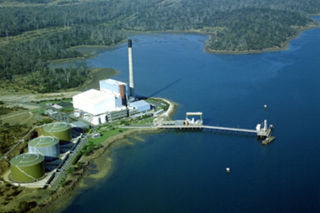
The Bell Bay Power Station was a power station located in Bell Bay, on the Tamar River, Tasmania, Australia, adjacent to the Tamar Valley Power Station, with which it was often confused. It was commissioned between 1971 and 1974 as an oil fired thermal power station, and was converted to natural gas in 2003, after the commissioning of the Tasmanian Gas Pipeline, a submarine gas pipeline which transports natural gas from Longford, Victoria, under Bass Strait, to Bell Bay, Tasmania. As the power station's primary role was to provide system security in the event of drought for Tasmania's predominantly hydro-electric based generation system it only was rarely called on to operate, resulting in intervals of five to eight years between periods of significant use. After the commissioning of Basslink in 2006, the power station was decommissioned in 2009.
Northern Power Station was located at Port Paterson in the Australian state of South Australia about 6 kilometres (3.7 mi) south of the city centre of Port Augusta. It was coal powered with two 260 MW steam turbines that generated a total of 520 MW of electricity. It was operated and maintained by Alinta Energy and was commissioned in 1985. Northern received coal by rail from the Leigh Creek Coal Mine, 280 km to the north. The plant ceased electricity production in May 2016 and decommissioned and demolished over the following few years.
Playford B Power Station was located at Port Paterson in the Australian state of South Australia about 5.5 kilometres (3.4 mi) south of the city centre of Port Augusta. It was coal powered with four 60 MW steam turbines that generated a total of 240 MW of electricity. Playford B received coal by rail from the Leigh Creek Coal Mine, 280 km to the north and drew cooling water from Spencer Gulf, returning it to the sea at an elevated temperature. Commissioned in 1963, it was co-located with the older Playford A Power Station and the larger, newer Northern Power Station. Playford B was mothballed in 2012 and its permanent closure was announced by operator Alinta Energy in October 2015. Prior to being mothballed, it primarily operated in the summer, when electricity demand peaks.
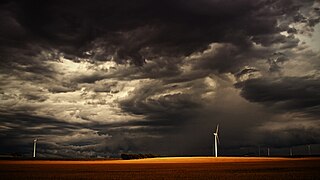
Alinta wind farm is a wind power station at Walkaway, just south of Geraldton, Western Australia. It is owned by Infigen Energy and has offtake agreements with Alinta Energy and AGL Energy.
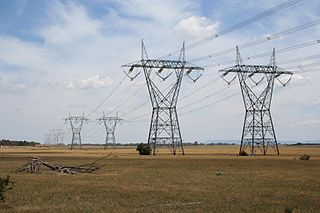
Energy in Victoria, Australia is generated using a number of fuels or technologies, including coal, natural gas and renewable energy sources. Brown coal, historically, was the main primary energy source for the generation of electricity in the state, accounting for about 85% of electricity generation in 2008. The amount of coal-fired power has decreased significantly with the closure in 2017 of the Hazelwood power station which supplied around 20% of Victoria's electricity, and to a lesser extent with the exit of Anglesea power station in 2015. Brown coal is one of the largest contributors to Australia's total domestic greenhouse gas emissions and a source of controversy for the country. Australia is one of the highest polluters of greenhouse gas per capita in the world.

SGSP (Australia) Assets Pty Ltd (SGSPAA), trading as Jemena, is an Australian company that owns, manages or operates energy infrastructure assets in the eastern states of Australia including Queensland and New South Wales, and gas pipelines and gas and electricity distribution networks in Victoria and the Northern Territory. It is 60% owned by State Grid Corporation of China and 40% by Singapore Power.
Tamar Valley Power Station is a $230 million natural gas-fired power station located in Bell Bay in the Tamar Valley, Tasmania. It is owned by Hydro Tasmania, and is immediately adjacent to the decommissioned Bell Bay Power Station, which is also owned by Hydro Tasmania.

Braemar Power Station is a complex of natural gas and coal seam gas fired combined-cycle power stations in Kogan, Western Downs Region, Queensland, Australia. It is near Dalby in the Darling Downs region.

Newman Power Station is a power station in Newman, Western Australia. It is located about 1,186 kilometres (737 mi) north of Perth, and nine kilometres (5.6 mi) north of the Tropic of Capricorn. It is a 178 megawatts (239,000 hp) natural gas-fired power station servicing BHP’s “islanded grid”. Newman currently provides 100% of the power requirement of the islanded grid which supplies electricity to the Area C mine operated by BHP.
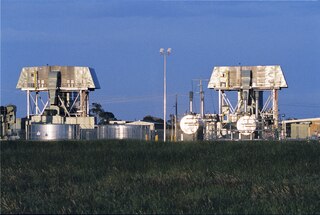
Bairnsdale Power Station is a 94 megawatts (126,000 hp) natural gas-fired power station in Victoria’s East Gippsland region, owned and operated by Alinta Energy. It is a fast start, peaking power station dispatching into the National Electricity Market. Bairnsdale Power Station is connected to the AusNet Services distribution network grid.
Alinta Energy is an Australian electricity generating and gas retailing private company owned by Hong Kong-based Chow Tai Fook Enterprises (CTFE). The sale for $4 billion was approved by Treasurer Scott Morrison in 2017. Alinta Energy has an owned and contracted generation portfolio of up to 1,957 MW, approximately 1.1 million combined electricity and gas retail customers and around 800 employees across Australia and New Zealand.
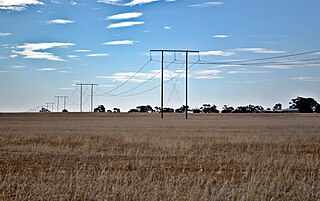
Reeves Plains Power Station is a proposal from Alinta Energy to build a gas-fired power station at Reeves Plains between Gawler and Mallala in South Australia. The proposed site borders both the Moomba-Adelaide gas pipe and an electricity transmission line. The power station is proposed to use six gas turbines to produce up to 300 megawatts (400,000 hp) of electricity. It is expected to be operated as a peaking plant rather than running full time. The primary source of fuel will be the gas pipeline, however the plant will also be able to operate on diesel fuel, and will have diesel storage on site. Stage 1 is expected to only be two or three of the turbines, generating 100 to 150 MW of electricity. The power station was originally expected to take 12 months to build, and be commissioned in January 2019. An extension of time request granted an additional 12 months in February 2019, but as of November 2019, the Alinta board had not yet decided to make the investment.










